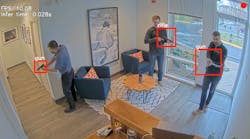This article first appeared in the August 2021 issue of Security Business magazine. When sharing, don’t forget to mention Security Business magazine on LinkedIn and @SecBusinessMag on Twitter.
The most obvious threat to all vertical markets over the past year has been COVID-19; however, as schools reconvene this fall in both K-12 and higher education, the pandemic may bring other unforeseen risks.
“We have been dealing with COVID in schools for more than a year and a half, and my biggest worry is that all eyes are focused on COVID (mitigation) when the threat of active attacks, disruptive attacks, and those types of things have not disappeared from the schools,” says Guy Grace, K-12 Unified Security Consultant and former Director of Security and Emergency planning for Littleton (Colo.) Public Schools. “In fact, because of the lack of stability in some students’ lives, it may be more likely that these attacks take place.”
COVID has piled on yet another massive risk to the myriad of multi-faceted and complex challenges that school districts face every day; and when it comes to preventing school violence, districts must strike an effective balance between physical security measures and behavioral prevention and monitoring.
With such a complex task, it remains up to security integrators to serve as trusted advisors to these school administrators to bring both technology and to help craft a strategy to deal with violence.
Unified and Automated Technology Response
The FBI says that most active shooter situations are over in less than five minutes – often before police can arrive. Technology should be focused on the prevention of harm – which means that detection and access control should be the key focuses when integrators create a technology plan for school violence detection and response.
“We don’t have the ability to look into the future and identify a crime before it happens, but we do have advanced technology to prevent how much harm an active shooter can do,” says Ara Bagdarsarian, Co-Founder of Omnilert, a provider of an end-to-end platform that combines AI-aided gun detection with emergency management. “Artificial intelligence and the Internet of Things have emerged in recent years, as well as (advances in) emergency notification and video analytics. But interoperability is absolutely key, because you may have all these different technology assets at a school or on a campus, but they don’t do much good unless they can work together.”
Bagdarsarian explains that the most important minute is the first minute of an active shooter situation. “This is where it is critical to notify people, to mobilize first responder resources, get the police and EMTs dispatched,” he says. “This needs to be done automatically – without having to call them. Automating the entire emergency response plan for active shooter events needs to happen within a matter of seconds, rather than a matter of minutes.”
This automatic response should include emergency mass notification to initiate shelter-in-place, as well as lockdown for interior rooms and/or lockout when an event is happening near the perimeter outside the facility.
Omnilert’s emergency mass communication and critical event management technology is one example of this type of automation. The open platform integrates with video, access control and even gun detection technologies to create an automatic response when an incident is identified. Additionally, its AI-based gun detection solution can be deployed on-premises by integrators and integrated with existing IP-based video surveillance systems.
“Once the firearm is detected, it enables the school or campus to instantly initiate those series of actions for lockdown, notifies everyone in the school grounds, and notifies the public via the website to not come to campus and that more information will follow,” Bagdarsarian says. “Emergency notification systems then use multiple channels of communication – text, voice and signage via classroom smart boards and screens (within the building).”
Bagdarsarian adds that the key thing for integrators to emphasize with school administrators is that automating what would take perhaps 20 different steps and doing that in a matter of seconds saves lives.
But Grace notes that it is important to understand that there is no one-size-fits-all solution for every school in America – highlighting the importance of the systems integrators. “Designs of schools on the east coast are quite different than the schools in Colorado or in the Midwest,” Grace says.
Traditional Technologies
Grace, who is also Chairman of the Partner Alliance for Safer Schools (PASS), recently published a whitepaper with best practices for active threat incidents in the K-12 environment (learn more at https://passk12.org/news/what-works-in-active-threat-incidents-best-practices-for-the-k-12-environment). In it, he outlines other areas where integrators should recommend technology solutions:
Mechanical Door Locks – Although hard-wired electronic access control systems offer the most secure solutions, they may not always be the most viable option for all openings due to budget constraints. Securing doors with a patented master key system is one of the most cost-effective means of securing a facility. There should also be a documented key control policy in place.
“I’m not talking about barricade devices – I’m talking about door locks that enable a student or staff member to have a push-button lock on the interior of the classroom,” Grace says. “A sturdy, industrial-grade lock will go a long way to keeping that room safe from a perpetrator; in fact, in our research we have found that there has not been a single a mechanical door lock breached in a school shooting.”
Standalone and Wireless Locks – These technologies help ensure all doors get locked in an emergency. The locks should have a visual indicator (locked or unlocked) that is visible from the interior of the room, and wireless fobs can be provided to staff that lock the door. If the school has lockdown and mass notification system, these fobs should be tied into the system to initiate the lockdown and lock the doors.
Radio Communications – Localized radios allow constant communications about what is happening on school grounds, and many school districts are starting to use the same 800mhz radio systems that police and fire officials use; whereas traditional two-way radio systems may be confined to a certain band (frequency) exclusive to the system. “Any school district that does not have the capability to have radio interoperability with law enforcement and fire should explore the implementation of this technology,” Grace says.
Access Control Systems – These management systems tend to be the backbone of a school or district’s entire physical security system. Effective and efficient access control will unify other safety and security technologies (video, mass-notification, alarms and fire) so that they can be used in different, productive ways.
Visitor Management Systems – These systems record photos of visitors or scan driver’s licenses. This not only helps confirm the identity of the presenter, but also checks for persons that should not be permitted to enter for a variety of reasons, such as restraining orders or parental rights disputes.
Video Management Systems – In addition to helping to tie many systems together, a video management system also provides valuable situational awareness during emergencies. Integrators should train designated school personnel to use the camera feeds in an emergency.
Video Intercom Buzz-In System – A video intercom should always be used when there is no direct line of sight to the person that is screening incoming visitors. These devices enable schools to speak with and observe visitors at main entrances and any other areas, such as loading docks, where people other than students, faculty and staff need to enter the building. The use of networked video intercoms is recommended, enabling screening from multiple devices such as a monitor in the front office or on mobile devices if needed. Networked video intercoms can also be recorded on the VMS.
Motion Detectors, Door Contacts and Beam Detectors – Time-tested intrusion detection technologies that protect school facilities from burglary and theft are also very valuable in active threat situations. Door contacts can be used to monitor doors for open status during business hours. Additionally, monitoring the status of the locks is important to ensure that not only is the lock closed, but the lock is also engaged. Motion detectors can be used in search and rescue efforts during an incident.
Duress and Panic Buttons – Most intrusion detection systems provide the ability to add new devices to the system in a cost-effective manner. One use of the intrusion system is to allow for duress/panic buttons or devices to be installed that provide users with the ability to trigger alarms for a variety of life safety threats. These devices should be installed in the main office and other public areas that would immediately communicate – and differentiate between – different types of emergencies or threats. Ensuring audio and video feeds in these areas should be considered.
Special Note on Fire Alarms – It is possible that during an active threat incident, a fire alarm will be initiated from gun smoke, fire or just a panicked person pulling a fire alarm. It is important for a school district to work with their local fire department to find a solution to override a fire alarm in an active shooter incident.





